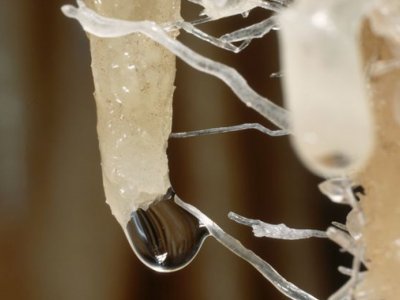Cave Description

The cave is part of an underground river bed, which was opened during the Proto-Tertiary period, about 1,500,000 years old (Ioannis Petrochilos). Its tourist route has a length of 1,100 meters and the area it covers is 14,800 m2, while its altitude difference from the entrance to the exit is about 25 meters. The air temperature is 180 Celsius, while the temperature of the waters of the small lakes that form inside the Cave is 140 Celsius. Their hardness is 180 French with P.H 5.5 and the humidity of the Cave reaches 100%.
Cave therapy
In recent years there has been growing interest in the problem of utilizing the spaces inside the caves to maintain the health of the human body. Man, many years ago, had known that some underground spaces have physico-chemical properties, which have a therapeutic effect on a number of diseases of the human body.
Interpretation of Beneficial Properties
We now know that the main factors are the following:
- The heat of the air and the currents it creates.
- Changes and relative humidity.
- The absence of ozone in the caves.
- The low or even zero content of microorganisms.
- Radioactive particles (radium products and gamma rays).
- The absence of dust, while there are small droplets of moisture.
- The acidic environment and the presence of calcium and magnesium and a number of other factors, natural, chemical of the caves have a positive effect on Climate Therapy.
Modern scientific research on the effect of the speleological environment on humans, clearly shows that caves can easily be turned into underground convents, where diseases can be treated and with the increased ability of the body to rejuvenate, all the above factors affect the health. the physical condition of the individual. And of course these factors are even more important, since they are used as a whole. These are not artificial, but natural factors. In the cave there is an atmosphere with low dynamics, compared to the outside. In fact, static ventilation does not create changes such as the outside atmosphere and any negative effects on the body.
In the environment of the cave there is a higher content of CO2 (Carbon Dioxide) than in the outside atmosphere. This CO2 content stimulates the respiratory centers and pushes for heavier breaths and this helps the patient to inhale larger amounts of therapeutic elements present in the cave. An important therapeutic factor is the molecules-particles charged with negative electricity (they are born under the influence of Lenard's Valoelectric). These particles circulate in the environment of the cave and in contact with the mucus of the human body, collide with the positive electricity of the nuclei in the membranes. The high concentration of calcium ions (ions) (Calsium) positively affect the stability of the body's cells. In both cases there is a significant treatment for allergic diseases such as Asthma.
The high content of Mg (magnesium) is also what brings beneficial results. The stability of the electric pole is one of the phenomena that has been insufficiently researched so far and which is of great importance, because the stony volume acts like a Faraday cage, not allowing electromagnetic instabilities of the external atmosphere. The importance of the radioactivity that was discovered, albeit in small doses, in most caves is relatively little known.
Also important is the weak Gama, typical in many areas of the caves. The wet environment in the caves has an acidic reaction, which from a microbiological point of view means that the caves are completely unsuitable for the multiplication - growth of bacteria.
All of the above factors seem exhausting. Studies (clinical) have shown that these factors affect the rejuvenation of the human body. At the Tresin Research Center in Olomouc, Moravia, where experts from the University Clinic and the University Medical Center work together, studies have shown that these agents have a therapeutic effect, helping to protect the body.
Cave therapy can be used in the following cases:
- In the treatment of chronic bronchial diseases of the respiratory system - Asthma.
- Rejuvenation of human organisms exposed to emissions of pollution, exhaust gases and other harmful factors from dense industrial area and cloud created in large cities.
- In the stabilization of the physical condition of organisms with chronic diseases, reduction of problems by 60-70%.
- In the treatment of dermatological diseases resulting from infections, allergic form.
The method of measuring the Cave Therapeutic agents was developed by the International Commission of UNESCO (IP8) and does not differ from the methods used in climatology and in the research of air purity, radiometry and similar research. In the Czech Republic there is 30 years of experience, while speleotherapy is also used in the following countries: Hungary, Russia, Austria, Germany, Italy, Poland, France, Romania. Cave therapy is applied to children aged 5 to 15 years. The duration of treatment is 21 days for 4 hours per day. This treatment is done in mines and salt mines.
Archaeozoology-Paleontology
After bio-speleological research carried out by the Swedish professor Mr. K. Lindberg, it was found that the insects of the following generations live in the Cave:
- Oligichetes
- Arpacticide (Maraenobiotus Brucei Carpatvicus Chapuis) Aselides
- Isopodes Terrestres
- Amphipodes
- Diplopodes Collemboles
- Arachnides Acariens
- As well as nymphs from various insects.
In the Cave of Perama, a new species of dolichopod was found for the first time in Greece by Ioannis Petrochilos and was studied by the French Biospiologist Chappuis who named it "Dolichopod Petrochilozi" in honor of the one who discovered it.








